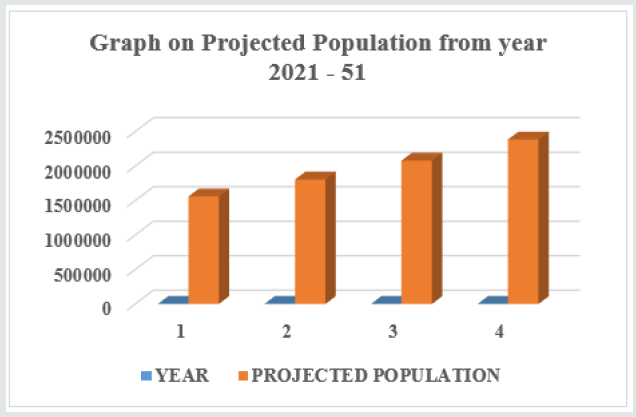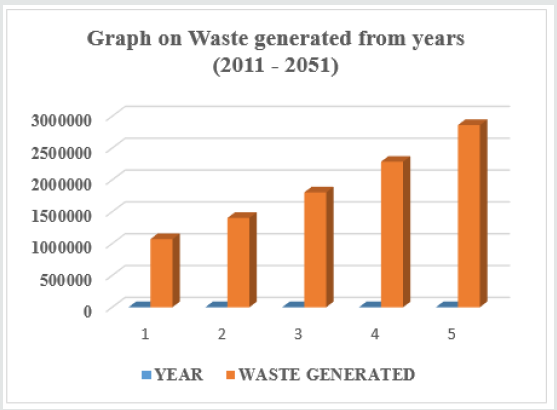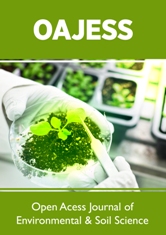
Lupine Publishers Group
Lupine Publishers
Menu
ISSN: 2641-6794
Review Article2641-6794 
Environmentally Sustainable Municipal Waste Management Strategy- A Case of Jamshedpur, India Volume 6 - Issue 1
Anindita Bhattacharjee1, Sheetal Kamble2 and Akshey Bhargava3*
- 1Masters in Urban Planning, BIT Mesra, India
- 2Assistant Professor, Environmental Science, P PSavani University, Surat, India
- 3Ex Rajasthan Pollution Control Board, Jaipur, CEPT University, India
Received: February 04, 2021 Published: February 19, 2021
Corresponding author: Akshey Bhargava, Ex. Rajasthan Pollution Control Board, Jaipur, CEPT University, Ahmedabad, India
DOI: 10.32474/OAJESS.2021.06.000228
Abstract
Municipal Solid Waste Management (MSWM) plays an important role in sustainable development. The motivation for the present study includes the abysmal state and challenges in MSWM in urban India. The concept of zero waste is a latest one for confounding waste problems of our society. Urbanization contributes to enhanced municipal solid waste (MSW) generation along with unscientific handling degrades the urban environment and causes health hazards. The expansion of urban areas, industrialization and changing patterns of consumption results in increased municipal waste generation which deteriorate the quality of environment, posing risk to the sustainable development. The seriousness of the problem increases in a scenario where natural resources are decreasing, and the traditional system of landfills still being practiced extensively for solid waste disposal. This paper addresses the issue of MSW by taking the case of Jamshedpur. It discusses the present municipal waste management system, new technologies, projected population, and solid waste generation. In an evolutionary approach, it points out the challenges that the sector is facing and makes an attempt to suggest a way forward through new technologies and estimation of value-added products that can be produced from the solid waste.
Keywords: Environment; sustainability; municipal sewage; management; generation trend; treatment options; economic viability
Introduction
Solid waste management includes seven principals which
makes it environmentally sustainable, they are – Rethink, Refuse,
Reduce, Repurpose and Repair, Reuse, Recycle and Rot. As far as,
solid waste management is concerned worldwide. Globalization
is one of the main reason which resulted into increase in the
generation of Industrial and hazardous wastes. An estimate of 2
billion tons per year of municipal waste is produced worldwide
and in the global scale 7–10 billion tons per year of ‘urban’ solid
waste is being produced all over the world which includes wastes
generated from households, commercial areas, industrial belts,
and construction sites [1]. But with the rapid globalization the
quantity of waste generated has gradually shifted from developed
countries to developing countries. In Developing countries increase
in population, migration from rural to urban areas, increase in the
area and number of urban areas to fulfil the requirements are some
of the basic interrelated reasons which leads to huge increase in
the municipal solid waste generated and is expected to increase to
a large amount at the end of a decade or two. By around 2050 the
total waste generated might increase up to 70 % of the what is being
generated presently and is being estimated to be nearly 3.4 billion
tonnes per year [2]. Although Developing countries have made a
significant progress in terms solid waste collection since 1990s,
but still nearly 2 billion people at an average have no access to
solid waste collection procedure [1]. In Developed countries there
was an increase in the waste generation during the initialization
of globalization and industrialization periods but gradually it
got stabled and through certain waste management techniques.
Compared to the developed nations, a major part of the population of
the developing countries specially the ones which belong to the lowincome
groups are majorly effected by unsustainable management
of solid wastes, nearly 90% of the wastes generated by the urban
poor are disposed of in non-confined areas or randomly dumped
or openly burned [2]. These practices have an adverse effect on the health and safety of livelihood and the environment as well. These
effects not only lead to the spreading of various diseases but also
one of the major factor responsible for climate change globally
(methane release). Henceforth, proper waste management is one
of the integral way to create a city which is sustainable and worth
living. But, it still remains a challenge for developing countries as
proper waste management is quite expensive and comprises of
nearly 20 -50% of the entire municipal budget to make it happen
[2].
In India, the population explosion and also the rapid increase
in the population rate in the upcoming years is one of the reasons
which is leading to huge amount of migration to urbanized areas.
Thus, due to increase of urbanization and also the increase in the
number of urban areas the amount of solid waste generated is also
increasing at a very fast rate. More than 377 million urban people
residing in 7,935 towns and cities generate an estimate of 62
million tonnes of solid waste per year, from which only 43 million
tonnes of waste is collected. Out of the wastes collected only 11.9
million tonnes of wastes are being treated and 31 million tonnes
of wastes are being dumped in landfill sites [3]. The landfill sites
of India are one of the largest sites in the world and is the third
highest emitter of greenhouse gases in the world [4]. In order, to
reduce the load on the landfill sites, the biodegradable wastes need
to be segregated and utilized to convert waste to compost and
bio-methanation plants, and the amount of biodegradable wastes
in India’s total solid wastes is more than 50% [3].Thus, municipal
bodies of various urban local bodies are implementing certain
solid waste management techniques including the collection,
transportation, disposal, and its treatment. Although, the results
of these implementations have certain obstacles such as the waste
producers, that is, the community residents, the commercial
area owners or the hospitals do not segregate their wastes while
disposing it off. But the problems are caused not only by the
community, even the contractors who are responsible for collection
and transportation of wastes cause problems as such, in order to
get maximum of profits, the transportation costs are being reduced
and thus the wastes are instead dumped in certain unauthorized
areas without even segregating.
This paper includes a case study to give certain techniques
as in how to make solid waste management environmentally
sustainable, which is of the city Jamshedpur. Thus, we need to know
some of the necessary things about Jamshedpur’s solid wastes and
its management. Depending on a survey conducted by CPCB with
the help of NEERI on 59 cities, Jamshedpur produces wastes of
338 Tons per day at a rate of 0.31 kg/c/day [5]. The type of wastes
of Jamshedpur mainely has high moisture content (48%) and has
a high calorific value (1009 kcal/kg). Out of the total wastes of
Jamshedpur collected, 43.36% of the wastes is worth composting
and 15.69% of the wastes can be recycled. The Jamshedpur’s solid
wastes C/N ration is estimated to be 19.69 [5,6]. According to
JUSCO who is responsible for the collection and transportation of
solid wastes in areas of the city which are maintained by JUSCO has
two dumping grounds as well, from these areas around 349 metric
tonnes of wastes are generated and this is expected to rise to 749
metric tonnes by 2031 [7].
Literature Review
It is seen that the waste generation of a city, town or country is much dependant on the demographics and economic status of that place. As per collection of generated waste in developing countries is concerned, according to [8] the frequency of collection of waste by municipalities from commercial areas ranges from 14 times a week to once a week. Whereas the rate of collection of wastes in inner city areas varies from 4 times a week to no collection in the entire week. In regard to treatment, it is observed as per [8] in developing countries about 40% of the countries do not have compost while other 60% of the countries can do composting to some extent but not fully. There is a positive correlation between composting techniques and domestic burning. Although domestic burning is purposely adopted in areas which lack proper collection and also lack of infrastructures of treatment. As per types of waste is concerned one of the major type of waste generated in countries and cities are organic wastes. According to [9] it is observed that amount of generated wastes at an average increase with the decrease in the socio-economic status of the respective areas. Henceforth, a larger amount of organic waste is generated from rural households as compared to the urban households. The disposal and treatment of MSW in India involves mainly two principal techniques as per [9], they are Composting (involves aerobic composting and vermicomposting) and Waste – to – Energy (involving, palletisation, biomethanation). Although conversion of Waste – to – Energy is a yet new concept as per as disposal and treatment of municipal wastes in India is concerned. The final outcome is in the form of energy, i.e., Power, Biofuel and Compost. Although these mechanisms have given positive outcomes when it was applied in developed countries. But as far as developing countries like India is concerned it is one the initial stages of application because of the testing factors like financial viability and sustainability [10]. According to Municipal Solid Waste (Management and Handling) Rules 2000 have required steps and initiatives which have been taken by all Local Administrative Bodies in order to improve Solid Waste Management in India [11]. Some of the rules of MSW – Rules 2000 include regular door to door collection, provision of secondary storage for MSW before disposal and finally provision of recycling of wastes and recovery out of it through composting in the form of energy like Biofuel, electricity etc. But Financial constraints is a major factor and also lack of infrastructure and proper technology are the major factors which is responsible for the backdrop in solid waste management in India [11].
Technological Options for Transforming Waste to Value added Products
Table 1 describes the various technological options that can be used to convert waste to useful products that can also be used in various forms of energy as well [12-17].
A Case Study of Jamshedpur
In order to explain how revenue generation from useful
products, generated from the municipal wastes, is a very big
contributing factor to the sustainable ways of treatment of solid
waste, this paper includes a case study of Jamshedpur. Jamshedpur
is one of the prominent town of Jharkhand within the District of
East Singhbum. It is an Industrial Town with various industries
more significantly Tata Steel, Tata Motors etc. It has a population of
13,39,400 (as per census 2011) including the urban agglomeration
as well. It is an industrial town including large scale as well as
small scale industries. Thus, apart from domestic and commercial
urban wastes a large amount of the type of solid wastes that are
generated in this city are Industrial wastes. In order to make solid
waste management sustainable we need to analyze the futuristic
projection of the solid waste that is generated and the outcome
which is projected so that it creates a sustainable and healthy
environment for the projected future population.
The Future decadal population projection is calculated
Mainly with 3 methods of calculation, that is through – Arithmetic
progression (AP), Geometric progression (GP) and Incremental
method.(as shown in Tables 1&2). The projected populations from
2021 – 51 helps to calculate the possible solid wastes generated
in these upcoming years. Starting with the year 2021, the solid
waste generated is 0.9 times the projected population of the
years 2021. Further as the decadal population increases and the
lifestyle changes in the upcoming years, the number of consumers
increases which leads to the overall increase in the waste generated
in the years ahead. Hence, 0.1 is added to 0.9 in each decade upto
2051. Also, the population of existing base year 2011 is less than
the projected populations, so less waste is generated in 2011 as
compared to that of from 2021 – 51, henceforth 0.1 is deducted
from 0.9 to calculate the waste generated in 2011. In order to make
the Solid waste management sustainable one of the essential steps
would be to convert the solid waste that is generated into products
or energies that would be useful for the society and the environment
around. The solid wastes that are generated is mainely divided into
two types of wastes, non-degradable and degradable. The nondegradable
waste is being utilised mainely in the production of
power or electricity. Whereas the degradable waste is used in the
production of compost and biofuel. Overall, it is seen that out of the
total solid waste that is generated 15% is non degradable wastes
and 85% is degradable wastes. Thus, the Tables 3 & 4 below will
show the amount of degradable and non-degradable wastes are
generated in the upcoming years from 2021 – 51 and the amount of
useful products extracted out of it which can be used in the form of
energies (Figures 1 & 2).
Table 1: Technological Options. Describes the various technological options that can be used to convert waste to useful products that can also be used in various forms of energy as well.
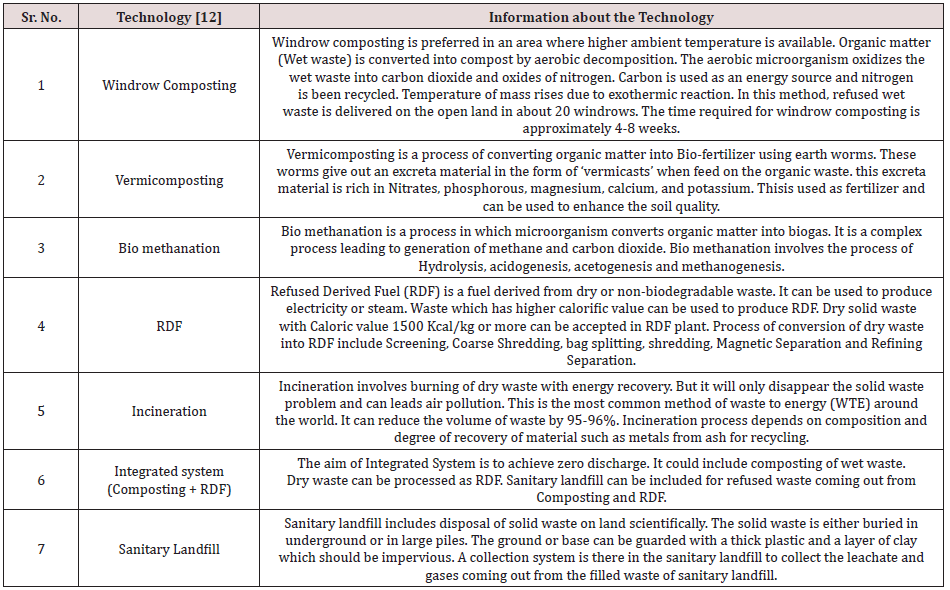
Table 2: Population Projection. Shows the decadal population projections from 2021 - 2051 by Arithmetic Progression, Geometric Progression, Incremental method and finally the average of it, depending on the existing population of 2011.

Table 3: Solid waste generated. Gives the total solid waste generated by the projected population from the year 2021 - 51 and of existing 2011 as well.

Table 4: Gives the amount of Non degradable waste that is generated out of the total solid wastes of 2021 - 51 and of existing 2011 as well and the power generated out of the non-degradable wastes.

*Note: (Power generated = Non degradable waste generated / 100).
In order to make it more sustainable and encourage these above-mentioned processes of solid waste management to convert the wastes into useful products which can be used as certain forms of energies, it is very necessary to consider the factor of revenue generation from these processes. The cost generating factor would make the municipal bodies to adopt these processes of converting wastes into useful forms of energies more frequently as giving monetary outcome along with making it a better and clean environment increases its socio-economic value and sustainability (Figure 3). An approximate rate is assigned to each of the useful resultantused as energies derived from the wastes. The assumption is based on the concept that the rate increases with increase in the decadal years in future due to appreciation as the projected population appreciates in the upcoming years producing rate of increase in the waste generated as well. The increasing rate also increases the economic value of the wastes generated in the future years as well. As far as conversion of non degradable wastes into power is concerned the rate assigned to the power generated is uniform throughout each decade and that is Rs. 4000 (per megawatt). Hence, the economic value of converting non degradable wastes to power is shown in the Tables 5 & 6 below. The rates assigned for the conversion of degradable wastes into Biofuel is 45 rupees (per litre) for the first projected year (i.e., 2021) and is increased by 15 rupees with the increase of each decadal year upto 2051 and 15 rupees is reduced for the existing decadal year (i.e., 2011) as the population and the waste generated depreciates in this case, as per the Tables 7 & 8 given below. Lastly, the rates assigned for the compost generated from the degradable wastes is 5 rupees (per Kilogram) for 2011, which is the existing decadal year and is increased by 5 rupees with the increase of each projected decadal year upto 2051, as shown in the Table 9 below.
Figure 3: The above graph gives an idea of the result of converting waste to products which can be very useful sources of energy and the revenue collected from it if we add up the cost generating factor to it.
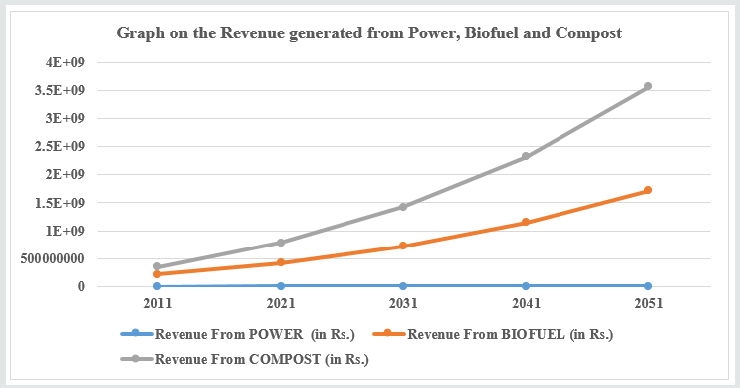
Table 5: Gives the amount of Degradable waste that is generated out of the total solid wastes of 2021 - 51 and of existing 2011 as well and the Biofuel generated out of the Degradable wastes.

*Note: (Biofuel generated = Degradable waste generated*21.43).
Table 6: Gives the amount of Degradable waste that is generated out of the total solid wastes of 2021 - 51 and of existing 2011 as well and the Compost generated out of the Degradable wastes.

*Note: (Compost generated = Degradable waste generated*83).
Table 7: Gives the revenue which can be generated when non degradable waste is converted into energy in the form of power per day and per year as well (expressed in Rupees)..

*Note: (Cost generated from Power per day = Non degradable waste generated*4000).
Table 8: Gives the revenue which can be generated when Degradable waste is converted into Biofuel which can be a great source of energy per day and per year as well (expressed in Rupees).

Table 9: Gives the revenue which can be generated when Degradable waste is converted into Compost per day and per year as well (expressed in Rupees).

Conclusion
With the rapid pace of urbanization in India and migration of village workers to urban areas, the solid waste generation is increasing thereby posing serious threat to environment and human beings. Municipal Solid Waste Management (MSWM) in India started from 1960, but has still not achieved any great success. Enforcement of effective legislations on take-back obligations should be in place. Therefore, appropriate planning and implementation of MSWM is crucial for maintaining sustainable development. The present case study highlights the significance of decentralized MSWM for Jamshedpur district which provides different scenarios that already exists and new technologies that could be adopted. The solid waste generation for the projected population is calculated along with the quantity of value-added products that could be derived from this waste. These methods are not only minimizing environmental risks but have enough potential to maximize the economic and technical aspects of waste. It is acclaimed that segregation of waste, combining with electricity and biogas recovery would be the best option for Municipal SWM. Moreover, these practices avoid the potential materials loss from MSW that increases the environmental and economic impacts. The district of Jamshedpur needs to innovate and evolve an efficient MSWM system with enough incentives, economic inputs and provisions which should be viable as well as socially acceptable. Since the major concern is the nature of mixed waste in MSW and its segregation, reduction of such organic waste generation by effective separate collection should be seen as an alternative route for effective MSWM.
References
- (n.d.). Global Waste Management Outlook. United Nations Environment Program.
- The World Bank IBRD I (2019)
- Lahiry S (2019) India’s challenges in waste management.
- The scenario of solid waste management in India (2016).
- http://cpcb.nic.in/wast/municipalwast
- Mir syeda yuhannatul humaira, MR (2016) Report on Municipal Solid Waste Management in Jamshedpur. Jamshedpur, India.
- University C (2027) Jamshedpur City Development Plan, India
- Lilliana Abarca Guerrero, GM, William Hogland (2013) Waste management . Solid waste management challenges for cities in developing countries 33(1): 220-232.
- Mufeed Sharholy, K A (2008) Municipal solid waste management in Indian cities – A review. 20(2): 459-467.
- Lal A (1996) Environmental status of Delhi. Indian Journal of Environmental Protection 16: 11.
- Arti Pamnani, Meka Srinivasarao (2014) municipal solid waste management in India: a review and some new results. Municipal solid waste management in India: a review and some new results 5(2): 1-8.
- Chapter XIV - Composting.
- Model Scheme for Vermi-Composting Units Under Agri-Clinics.
- Vermicomposting- A Step by Step Procedure to Vermicomposting.
- Irini Angelidaki, Dimitar Karakashev, Damien J Batstone, Caroline M Plugge, Alfons JM Stams (2011) Biomethanation and its potential. 494: 327-351.
- What is Refuse-derived fuel (RDF)? Can RDF be a solution to waste management in India? Are there any provisions regarding the same in the Solid Waste Management Rules, 2016? Elucidate. – GK Today.
- RDF (Refuse Derived Fuel) Explained.

Top Editors
-

Mark E Smith
Bio chemistry
University of Texas Medical Branch, USA -

Lawrence A Presley
Department of Criminal Justice
Liberty University, USA -

Thomas W Miller
Department of Psychiatry
University of Kentucky, USA -

Gjumrakch Aliev
Department of Medicine
Gally International Biomedical Research & Consulting LLC, USA -

Christopher Bryant
Department of Urbanisation and Agricultural
Montreal university, USA -

Robert William Frare
Oral & Maxillofacial Pathology
New York University, USA -

Rudolph Modesto Navari
Gastroenterology and Hepatology
University of Alabama, UK -

Andrew Hague
Department of Medicine
Universities of Bradford, UK -

George Gregory Buttigieg
Maltese College of Obstetrics and Gynaecology, Europe -

Chen-Hsiung Yeh
Oncology
Circulogene Theranostics, England -
.png)
Emilio Bucio-Carrillo
Radiation Chemistry
National University of Mexico, USA -
.jpg)
Casey J Grenier
Analytical Chemistry
Wentworth Institute of Technology, USA -
Hany Atalah
Minimally Invasive Surgery
Mercer University school of Medicine, USA -

Abu-Hussein Muhamad
Pediatric Dentistry
University of Athens , Greece

The annual scholar awards from Lupine Publishers honor a selected number Read More...




